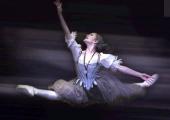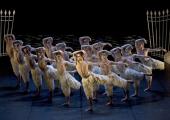Nevermore, Barbican Theatre



A thousand miles away from the Disney version, the transformation scene in Dvořák’s Rusalka is bleak and terrifying. With not a cauldron, bat or cobweb to be seen, the heroine is strapped to an operating table before imbibing the witch’s magic potion intravenously. Then her legs, until now swaddled together, are literally torn apart. It’s a brutal, shocking moment; no surprise that some audience members giggled nervously.

No longer, it seems, need ballet's most transformable heroine languish by the seasonal fireside. It's true that you'll have to wait until Christmas to see the most visually striking Cinderella of all again - Ashley Page's fitfully ingenious Scottish Ballet version showcasing magical designs by Antony McDonald. But English National Ballet's Cinders is out and about this spring, and now Ashton's first full-length triumph returns with period glitter to Covent Garden.

Was it with a hollow laugh that ENB programmed Cinderella for the election period - as a reminder that glittery fairy phaetons are in fact pumpkins with money? Was it a hint that ballet needs political fairy godmothers? With airwaves full of budget cuts, nothing was more welcome yesterday than to go into a Bristol Hippodrome matinee, full of noisy children, and watch this delightful fairytale of wish-fulfilment laid before them. Even better, with the radiant Elena Glurdjidze as the ash girl.

Although our culture is obsessed with youth, very few adults can connect directly with teenagers. Instead teens have become the object of our fears — there’s even a posh word for this: ephebiphobia. In drama, teens are often portrayed as a problem to be solved, and deprived of their own voices. By welcome contrast, Philip Ridley’s Moonfleece, which opened last night in London and will tour the north of England, is unforgettably teenage in every way — it is young, young, young!

Neil Jordan’s smaller films have often betrayed a fascination with wispy visitants from the borderlands of gender. In The Crying Game the beautiful young call girl turns out, in one of cinema’s more jawdropping reveals, to be somewhat less she than he. Breakfast on Pluto found Cillian Murphy’s girly boy swishing around working-class Dublin in frocks and furs. And now comes Ondine, Jordan’s reimagining of the watery fable transplanted to the rugged shores of Cork.

For those of us brought up on classic Disney animation - from the first, Snow White and the Seven Dwarfs, through The Jungle Book and Lady and the Tramp to, more recently, The Lion King and Beauty and the Beast - it’s sad to think that a whole generation of children have seen animated films only through CGI and Pixar. But now comes The Princess and the Frog, Disney’s first entirely 2D, hand-drawn animation since 2002, which, with its sumptuous drawings, soft colours and Jazz Age setting, could almost be seen as a retro exercise.

If your heart feels frozen while the ice glitters outside, warm it by reading Hans Christian Andersen's sharp, witty and enchanting fairy-tale The Snow Queen, or listen to the best bits of Prokofiev's erratic but often characteristic late ballet The Stone Flower. You could also drag yourself out into the cold to face Michael Corder's full-length choreography based on the Andersen story, selectively fitted to chunks of the Prokofiev score and interspersing them with other lyric highlights of the composer's Soviet period, but that would have to be a third-best option.

For a choreographer the moment your work becomes a classic is when the audience tells you that you’re casting it wrong. I’ve seen Matthew Bourne’s Swan Lake more than a dozen times for professional reasons since it first took off from Sadler’s Wells nearly 15 years ago, and it’s not Adam Cooper’s blinding image all those years ago that’s telling me the press night cast last night wasn’t delivering what the work is worth. It's because I have come to own this piece in my own imagination.
